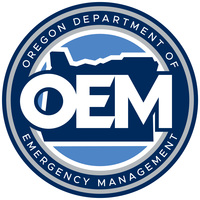Take action to prepare for flash floods, landslides and debris flows
Salem, Ore. – Oct. 27, 2022 – Oregon has entered the rainy season while recovering from consecutive years of intense wildfires. Oregon Emergency Management (OEM) is warning people living and traveling in and around wildfire-impacted areas of the increased risk of flooding, landslides and debris flows associated with burn scars and encouraging Oregonians to sign up for emergency alerts, exercise caution and plan ahead.
Wildfires dramatically change the landscape and ground conditions, which can lead to a higher risk of flooding. Natural, unburned vegetation and soil normally act as a sponge during a rainfall event, but after an intense wildfire, burned vegetation and charred soil form a water-repellent layer that blocks water absorption. As a result, properties located below or downstream of the burn areas are at an increased risk for flooding, debris flows and landslides. Even areas not traditionally flood-prone are at risk of flooding for several years after a wildfire.
“We’ve experienced incredibly destructive wildfires in Oregon over the past three years, and their effects linger even after the flames are out,” said OEM Director Andrew Phelps. “Oregonians in or near these impacted areas need to be aware that threats like flash floods and debris flows can happen quickly with little to no warning. People need to pay attention to emergency alerts and local weather forecasts and leave if they are told to evacuate or if they feel unsafe.”
OEM recommends people take basic preparedness actions for all types of disasters, including staying informed, being aware of surroundings, having a plan for emergencies and being prepared with an emergency kit.
Stay informed
- Monitor the weather forecast for watches, warnings or advisories at Weather.gov.
- Sign up for local emergency alerts at ORalert.gov.
- If told to evacuate, do so immediately using a planned evacuation route least likely to be impacted by flash flooding and debris flow.
Drive with caution
- Be aware of the latest road conditions before driving by checking Tripcheck.com.
- Be alert when driving; embankments along roadsides may fail, sending rock and debris onto the road.
- Turn on lights, increase the following distance and slow down.
- Don’t drive through flood water; just 6 inches of fast-moving flood water can knock over an adult, and a foot of rushing water can carry away most cars.
Understand flood advisories, watches and warnings
- A Flood Advisory is issued when a forecasted specific weather event may become a nuisance: Be aware.
- A Flood Watch is issued when conditions are favorable for flooding to occur: Be prepared.
- A Flood Warning is issued when flooding is imminent or already occurring: Take action.
Look for signs of landslides
- Look for changes in the landscape like leaning trees, land movement, or a trickle of falling mud or debris.
- Pay attention if the water in streams or creeks suddenly turns muddy or the water flow suddenly decreases or increases.
- Listen for unusual sounds, such as trees cracking or boulders knocking together, that might indicate moving debris.
Develop an emergency plan that includes emergency kits for your home, work and vehicles. When any disaster occurs, it could take days to weeks for first responders to reach everyone impacted. Oregonians need to be as prepared as possible in an emergency. OEM recommends every household be 2 Weeks Ready, meaning they have a plan and enough food, water and supplies to survive for at least two weeks following a disaster. Recognizing disasters disproportionately impact marginalized communities, OEM offers several equitable and accessible readiness resources to help inform all Oregonians of their risks and ways to prepare.
Oregonians should also recognize the importance of flood insurance and be aware that home and rental insurance policies don’t cover flood damage. Flood insurance is a separate policy that typically takes 30 days to go into effect. For more information about flood risk and mitigation, visit Ready.gov/floods. For details on landslides and debris flow, visit Ready.gov/landslides-debris-flow. For flood facts including flood zones and maps, risk and costs, and insurance coverage, visit the National Flood Insurance Program at Floodsmart.gov.
# # #
You can get this document in other languages, large print, braille, or a format you prefer. For assistance, email licinfo@oem.oregon.gov“>OEM_publicinfo@oem.oregon.gov or dial 711.












